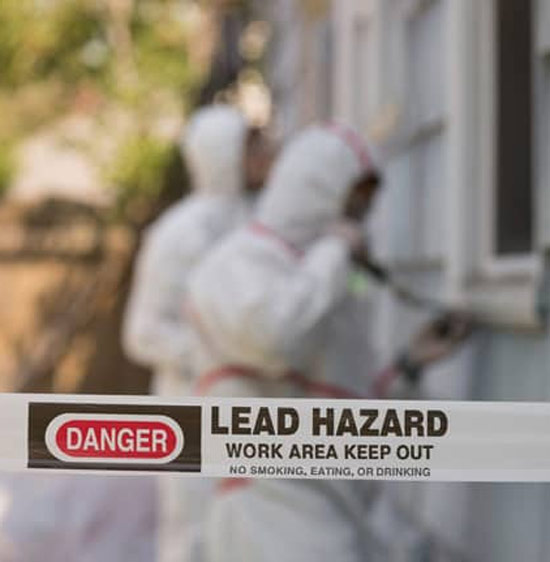Professional Lead Violation Removal in NYC-- Secure Against Health Hazards
Professional Lead Violation Removal in NYC-- Secure Against Health Hazards
Blog Article
Comprehensive Overview on Effective Lead Infraction Elimination Methods
In the world of ecological safety, resolving lead violations demands a precise and structured technique. This thorough overview starts by highlighting the important first steps of determining lead risks with sophisticated evaluation and testing techniques. The guide specifies on the value of sticking to stringent safety methods during the elimination procedure, including the use of proper PPE and separating influenced areas.
Determining Lead Threats
Determining lead hazards is a critical initial step in reducing the dangers connected with lead direct exposure. Lead, a poisonous steel, can be existing in various ecological tools, consisting of paint, dirt, water, and dirt. It postures severe health threats, particularly to children and expectant females, bring about neurological damages and developing hold-ups. Accurate identification of potential lead resources is necessary for reliable remediation.
The initial stage in determining lead hazards includes recognizing usual lead resources within the constructed setting. Frameworks developed prior to 1978 are especially prone due to the prevalent use lead-based paint during that period. Furthermore, dirt contamination can take place from deteriorating outside paint, industrial exhausts, or historic use leaded gasoline.
Another substantial source is lead piping and plumbing components, which can seep lead right into drinking water. Durable goods such as toys, ceramics, and imported items may additionally consist of dangerous lead levels. Notably, job-related environments and hobbies including lead can track pollutants into homes.
Assessment and Testing
When attending to lead dangers, effective evaluation and testing are critical. This crucial action ensures the identification and quantification of lead visibility, therefore leading subsequent remediation efforts. Preliminary analysis typically entails a visual evaluation to recognize possible lead sources, such as degrading paint or polluted dirt. This is enhanced by even more strenuous screening techniques to establish the extent of contamination.

Dirt wipe sampling is another essential strategy, especially in residential setups. By accumulating examples from floors, windowsills, and other surfaces, this technique supplies insights into possible exposure dangers. Moreover, dirt testing around building boundaries is crucial to spot lead contamination that might posture hazards, particularly to youngsters.
Safe Elimination Treatments
Upon finishing comprehensive assessment and testing, implementing safe removal treatments is the following critical phase in addressing lead threats. This procedure makes certain that lead-contaminated materials are effectively and securely gotten rid of, lessening danger to both workers and citizens. The primary step involves separating the damaged location using plastic bed linen and appropriate securing methods to stop the spread of lead dirt.
Employees need to put on proper personal protective tools (PPE), consisting of respirators, gloves, and disposable coveralls, to reduce direct exposure. Using specialized devices and wet techniques, such as wet fining sand or utilizing HEPA-filtered vacuum cleaners, lowers the diffusion of lead fragments. It is important to avoid completely dry sanding or rough blowing up, as these methods can generate dangerous lead dust.
Waste disposal is one more important element; all contaminated products need to be firmly bagged and labeled according to EPA and neighborhood regulations. In addition, complete cleaning of look what i found the work location with HEPA vacuum cleaners and damp cleaning makes sure the removal of recurring lead particles.
Post-Removal Confirmation

Confirmation of successful lead removal, called post-removal verification, is vital to ensure the safety and habitability of the remediated area. This process includes a collection of thorough assessments and tests designed to identify any type of recurring lead particles that may present wellness risks. The preliminary action normally consists of an aesthetic assessment to analyze the conclusion and high quality of the remediation job. This inspection makes sure that all well-known sources of lead have been addressed which no visible indications of contamination continue to be.
Complying with the aesthetic inspection, environmental sampling is conducted. This includes accumulating dust, dirt, and sometimes water examples from the remediated area. Approved research laboratories analyze these examples to gauge lead levels, ensuring they fall listed below the safety limits developed by regulative read the full info here bodies such as the Epa (EPA)
On top of that, air top quality screening may be performed to identify airborne lead bits, especially in instances where substantial lead-based paint elimination or improvement has happened. The outcomes of these examinations give quantitative information confirming that the lead levels are within permitted restrictions.
Ultimately, post-removal verification functions as a critical checkpoint, verifying the efficiency of the lead abatement initiatives and protecting the health and wellness of owners and site visitors.
Preventive Measures and Upkeep

A crucial precautionary action consists of making use of lead-safe licensed specialists for any renovation, repair work, or painting tasks. These specialists are trained in practices that lessen lead dirt and particles. Furthermore, maintaining coloured surface areas to prevent damaging or peeling is essential, as deteriorating paint can launch lead fragments right into the environment.
Educational initiatives targeting homeowner and lessees pertaining to the risks of lead and the value of reporting any potential threats can additionally improve precautionary initiatives. Regular cleansing making use of HEPA vacuums and damp mopping techniques can considerably reduce lead dust accumulation.
Conclusion
In summary, effective lead infraction removal demands a thorough strategy incorporating extensive analysis, precise testing, and strict elimination procedures. Ensuring safety and security with correct seclusion and personal safety devices continues to be extremely important. Post-removal confirmation via ecological tasting and air top quality testing substantiates compliance with recognized safety criteria. Ongoing examinations and maintenance are crucial to reduce future lead risks, thus guarding public health and wellness and making certain continual conformity with regulative requirements.
Report this page